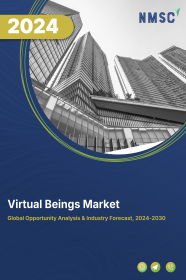
Virtual Beings Market by Type (Avatars, Chatbots, and Autonomous Virtual Humans), and by Industry Vertical (BFSI, Education, Retail, Healthcare, Automotive, IT & Telecommunications, Gaming, & Entertainment, and Others): Global Opportunity Analysis and Industry Forecast, 2024–2030
Market Definition
The global Virtual Beings Market size was valued at USD 28.04 billion in 2023 and is predicted to reach USD 305.67 billion by 2030 with a CAGR of 40.8% from 2024 to 2030. Virtual beings are artificial intelligence (AI) driven computer-generated digital characters that are designed to interact with humans to mimic human-like behavior, thought processes, and emotions such as facial recognition capabilities, which allow them to analyze verbal and nonverbal cues to understand and respond to human emotions.
These entities can interact with humans through various mediums such as social media, chatbots, and virtual reality through virtual agents or digital humans. Virtual beings can range from simple chatbots that perform basic tasks to sophisticated virtual characters that can hold conversations, make decisions, and express emotions. They can be programmed to simulate human-like conversations, offer advice, and provide companionship.
Market Dynamics and Trends
The rapidly growing gaming and entertainment industry coupled with the growing interest in virtual socializing and connecting with others in virtual spaces are fostering the virtual beings market growth. Moreover, with the advancements in technology, such as the use of artificial intelligence and natural language processing, virtual beings are becoming more intelligent and responsive, allowing them to interact with users in more natural ways, thereby boosting the growth of the global market. Furthermore, the growing adoption of virtual beings in industries such as customer service, education, and healthcare to improve customer experience and increase operational efficiency is further driving the growth of the market.
However, the chances of technical issues in virtual beings and the potential for exploitation and privacy issues are the major factors restraining the growth of the virtual beings market. On the contrary, the integration of augmented reality (AR) and virtual reality (VR) to create more immersive and interactive virtual experiences coupled with the introduction of 5G and web 4.0 to improve the performance and responsiveness of virtual beings are expected to create ample opportunities in the growth of the market in the coming years.
Market Segmentations and Scope of the Study
The virtual beings market report is segmented on the basis of type, industry vertical, and region. On the basis of type, the market is divided into avatars, chatbots, and autonomous virtual humans. Avatars are further segmented into Interactive digital human avatar and non-interactive digital human avatar. On the basis of the industry vertical, the market is classified into BFSI, education, retail, healthcare, automotive, IT & telecommunications, gaming, & entertainment, and others. The regional breakdown and analysis of each of the aforesaid segments include regions comprising of North America, Europe, Asia-Pacific, and RoW.
Geographical Analysis
North America holds the lion's share of the virtual beings market and is expected to continue its dominance during the forecast period. This is attributed to factors such as the growing gaming industry in countries such as the U.S. and Canada and the creation of more immersive and interactive gaming platforms by integrating virtual beings for human-like experiences drive the growth of the market. According to the American Gaming Association (AGA), commercial gaming revenue reached USD 60.42 billion in 2022, which is a 13.9 percent increase over 2021 and 38.5 percent higher than 2019.
Moreover, the developed healthcare industry in North America and the growing adoption of virtual beings to enhance patient care and improve medical training such as surgical simulation further drive the growth of the virtual beings market. According to the Centers for Medicare & Medicaid Services, national healthcare industry reached 4.3 trillion in 2021 in the United States as compared to USD 4.1 trillion in 2020.
On the other hand, Asia Pacific is expected to create ample opportunities for the growth of the virtual beings market. This is due to the BFSI (Banking, Financial Services, and Insurance) sector increasingly using virtual beings to improve customer experience, provide personalized financial advice, and risk management further drive the growth of the virtual beings’ market. According to the China Banking and Insurance Regulatory Commission, China's BFSI is one of the largest industries in the world with total assets of this sector valued at USD 51.19 trillion in 2022. Innovative technologies, such as virtual beings and virtual assistants, are expected to drive the demand within the market, as organizations aim to enhance customer experiences and offer personalized services.
Moreover, the rapidly growing telecom industry in this region along with the increasing adoption of virtual assistants and chatbots in smartphones to enhance customer experience and streamline operations in this industry drive the growth of the virtual beings market. According to the Indian Ministry of Information and Broadcasting, the number of smartphone users reached 600 million in India in 2022 as compared to 492.78 million in 2021. As more people gain access to these technologies, the popularity for virtual beings and virtual assistants is significantly growing in this region.
Competitive Landscape
The market players operating in the global virtual beings industry include Meta Platforms, Inc., Magic Leap, Inc., Microsoft Corporation, Apple Inc., Google LLC, Niantic, Inc., Unity Technologies, HTC Corporation, Sony Interactive Entertainment, NVIDIA Corporation, and others. These market players are adopting various strategies such as product launches to maintain their dominance in the global market.
Moreover, in October 2022, Meta introduced its virtual reality headset named Quest Pro virtual. The VR headset features the capability to blend digital and real-world environments, offering an immersive experience to various applications, including gaming, virtual meetings, and other extended reality experiences. Furthermore, in August 2021, Sesorium introduced AI-driven virtual avatars in company's virtual world named Sensorium Galaxy. Through this launch, the company aims to provide a virtual platform to people to interact and communicate with digital beings in the virtual world.
Key Benefits
-
The report provides quantitative analysis and estimations of the virtual beings market from 2024 to 2030, which assists in identifying the prevailing market opportunities.
-
The study comprises a deep dive analysis of the virtual beings market including the current and future trends to depict prevalent investment pockets in the market.
-
Information related to key drivers, restraints, and opportunities and their impact on the market is provided in the report.
-
Competitive analysis of the players, along with their market share is provided in the report.
-
SWOT analysis and Porters Five Forces model is elaborated in the study.
-
Value chain analysis in the market study provides a clear picture of roles of stakeholders.
Virtual Beings Market Key Segments
By Type
-
Avatars
-
Chatbots
-
Autonomous Virtual Humans
By Industry Vertical
-
BFSI
-
Education
-
Retail
-
Healthcare
-
Automotive
-
IT & Telecommunications
-
Gaming & Entertainment
-
Others
By Region
-
North America
-
The U.S.
-
Canada
-
Mexico
-
-
Europe
-
The UK
-
Germany
-
France
-
Italy
-
Spain
-
Denmark
-
Netherlands
-
Finland
-
Sweden
-
Norway
-
Russia
-
Rest of Europe
-
-
Asia Pacific
-
China
-
Japan
-
India
-
South Korea
-
Australia
-
Indonesia
-
Singapore
-
Taiwan
-
Thailand
-
Rest of Asia Pacific
-
-
RoW
-
Latin America
-
Middle East
-
Africa
-
Report Scope and Segmentation
|
Parameters |
Details |
|
Market Size in 2023 |
USD 28.04 Billion |
|
Revenue Forecast in 2030 |
USD 305.67 Billion |
|
Growth Rate |
CAGR of 40.8% from 2024 to 2030 |
|
Analysis Period |
2023–2030 |
|
Base Year Considered |
2023 |
|
Forecast Period |
2024–2030 |
|
Market Size Estimation |
Billion (USD) |
|
Growth Factors |
Growing gaming and entertainment industry Advancements in technology, such as the use of artificial intelligence (AI) Rising adoption of virtual beings in industries such as customer service, entertainment, education, and healthcare |
|
Countries Covered |
28 |
|
Companies Profiled |
15 |
|
Market Share |
Available for 10 companies |
|
Customization Scope |
Free customization (equivalent up to 80 working hours of analysts) after purchase. Addition or alteration to country, regional, and segment scope. |
|
Pricing and Purchase Options |
Avail customized purchase options to meet your exact research needs. |
Key Players
-
Meta Platforms, Inc.
-
Magic Leap, Inc.
-
Microsoft Corporation
-
Apple Inc.
-
Google LLC
-
Niantic, Inc.
-
Unity Technologies
-
HTC Corporation
-
Sony Interactive Entertainment
-
NVIDIA Corporation




















 Speak to Our Analyst
Speak to Our Analyst
























